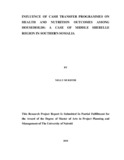| dc.description.abstract | This study aimed at examining the influence of Cash Transfer programmes on health and nutrition outcomes among the households in Middle Shebelle Region in Southern Somalia. The study was guided by the following objectives: to establish the influence of conditional cash transfer programmes on health and nutrition outcome in Middle Shebelle Region in Southern Somalia; to examine the influence of unconditional cash transfer programmes on health and nutrition outcome in Middle Shebelle Region in Southern Somalia; to assess the influence of criteria used in cash transfer programmes on health and nutrition outcomes among households in Middle Shebelle Region and to determine the influence of M&E of cash transfer programme on health and nutrition outcomes among households in Middle Shebelle Region. This study employed descriptive research design. The study thus employed qualitative and quantitative methods. To achieve qualitative data, the study used both key informant interviews and focused group discussions. FGDs included groups of people benefitting from cash transfer while KIIs targeted community leaders and officers in charge of cash transfer program. Quantitative methods were used to collect information from beneficiaries, their spouses and head of household in different household levels by use of questionnaires. The study used purposive sampling. The individuals included in the study were household heads, community leaders and program officers. Purposive sampling was used to identify individual and households that were participating in Cash Transfer Programs. Data was collected by use of primary means of data collection. Thus the following instruments were used; questionnaires, key informant interviews (KIIs) and focused group discussions (FGDs). Collected data from all the instruments was thoroughly checked before analysis was done. Quantitative data was coded using SPSS version 21. Data was analyzed using frequencies, percentages, means and standard deviation. Presentation was mainly in form of tables. Qualitative data was analyzed using content analysis. The arising themes from each objective were noted and explanation thereafter done. Findings show that majority of the respondents received conditional cash transfer. The study further concludes that women and old people are more vulnerable to poverty and limited access to alternative empowerment opportunities. The study finally concludes that cash transfer program have played a significant role in improving health and nutrition outcome of the beneficiaries. The study recommends that program owners should consider improving the infrastructure. The government should improve security by encouraging the residents to go in groups when accessing their cash transfer. The NGOs should consider offering counselling program to the cash transfer beneficiaries. The program officers should consider issuing electronic cash as opposed to liquid cash. | en_US |



